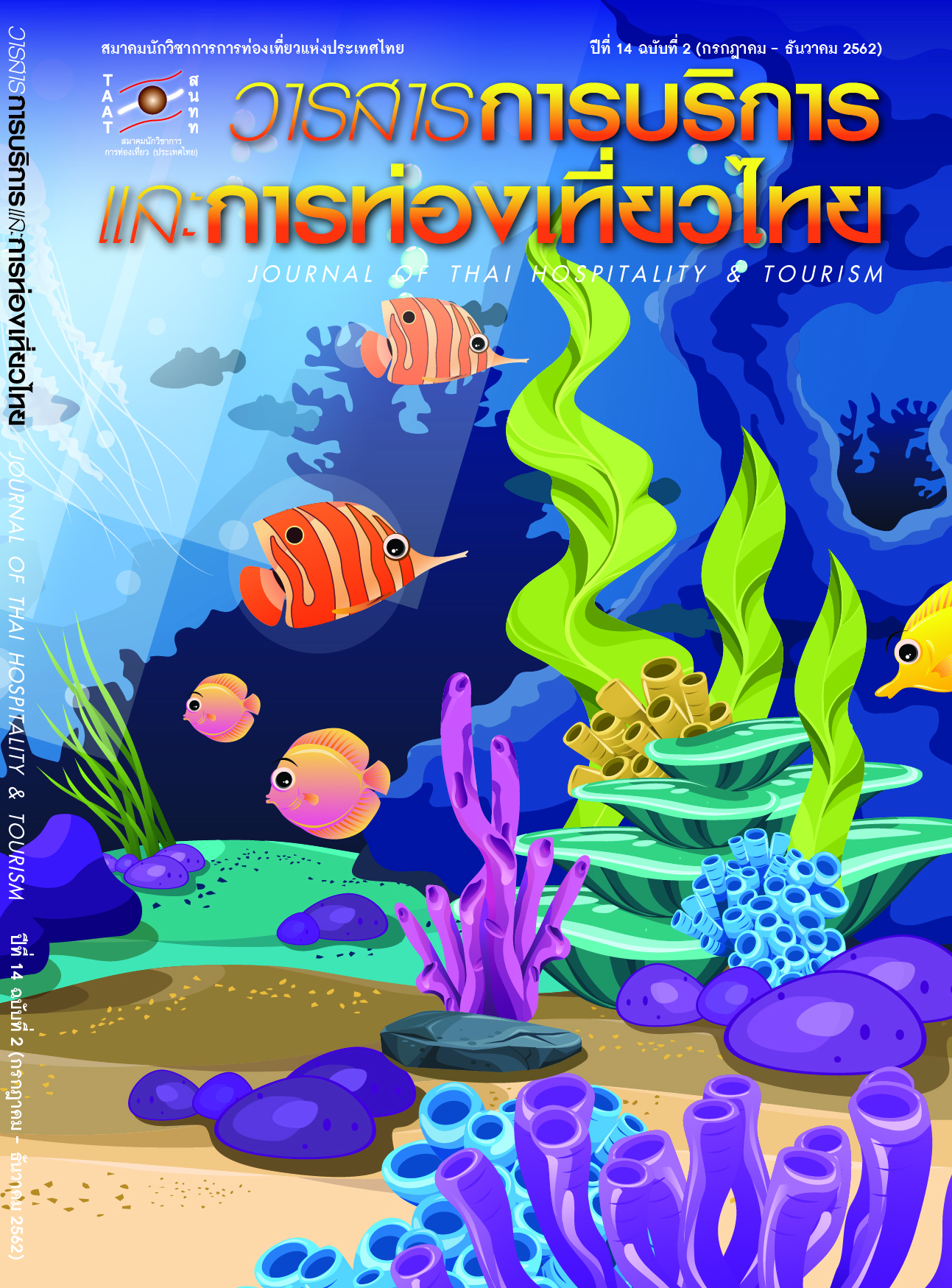Definition and Service Form of Wellness Tourism in the Upper Northern Region, Thailand
Main Article Content
Abstract
The research entitled “Definition and service form of wellness tourism in the Upper Northern Region, Thailand” consisted of 2 parts. The first part aimed to define and study the form of wellness tourism in 3 provinces of the Upper Northern region, which were Chiang Mai, Chiang Rai, and Mae Hong Sorn. Data was collected through focus group discussion with 10 persons involving in wellness tourism, such as professors, experts, and representatives from government and private organizations related to wellness tourism. In the second part, researchers studied the operation of 11 wellness tourism businesses in Chiang Mai, Chiang Rai, and Mae Hong Sorn to investigate business operation, types of business, and service readiness. Data was collected through in-depth interview with business owners or their representatives. The interviews were conducted with 6 businesses in Chiang Mai, 2 businesses in Chiang Rai, and 2 businesses in Mae Hong Sorn.
From the focus group discussion, wellness was defined as the state of balancing physically, mentally, and spiritually, resulting in happiness. Also, wellness tourism was defined as the journey emphasis on activities that promote physical, mental, and spiritual balance. Service providers must include accommodation as well as wellness activities. The focus group also classified wellness tourism activities into 3 groups; active activity, semi-active activity, and passive activity. The first group included activities that participants conducting the activities by themselves. The last group included activities that other person performed activities for the participants. Activities in the second groups lied in-between.
When investigating business operation in wellness tourism in Chiang Mai, Chiang Rai, and Mae Hong Sorn, the study revealed that each province offered different forms of wellness services. In terms of tourism accommodation, the study found that each location should focus on accessibility. In addition, the study found that businesses in those three provinces possess different service potential.
Article Details
References
[2] Chen, J. S., Prebensen, N., & Huan, T. C. (2008). Determining the Motivation of Wellness Travelers. International Journal of Tourism and Hospitality Research, 19(1), 103-115.
[3] Georgiev, G. & Vasileva, M. T. (2010). Conceptualization and Classification of Balneo, Spa and Wellness Establishments in Bulgaria. UTMS Journal of Economics, 1(2), 37-44.
[4] Hjalager, A. & Konu, H. (2010). Cosmeceuticals in Wellness Tourism – Cases of Co-branding and Co-creation. Proceeding of the Travel and Tourism Research Association Europe 2010, 1-3 September 2010, Budapest Hungary, 67-75.
[5] Huijbens, E. H. (2011). Developing Wellness in Iceland: Theming Wellness Destinations the Nordic Way. Scandinavian Journal of Hospitality and Tourism, 11(1), 20-41.
[6] Jariangprasert, Nittaya., Maneesong, Orachorn., et al. (2005). Development of Knowledge in Ecotourism of Mae Sarieng District, Maehongsorn Province: The Case of Tambol Mae Hoh. Research Report. Faculty of Business Administration, Chiang Mai University.
[7] Kaosa-ard, Mingsarn. (2005). Retained Value of the Tourism Industry of Thailand. Research Report. Social Research Institute, Chiang Mai University.
[8] Királová, K. (2010). Health Spa and Wellness – Competition or Supplement? The Czech Republic case. Proceeding of the Travel and Tourism Research Association Europe 2010. 1-3 September 2010, Budapest Hungary, 121-143.
[9] Komppula, R. & Pesonen, J. (2010). Rural Tourism, A Form of Wellbeing Tourism?. Proceeding of the Travel and Tourism Research Association Europe 2010. 1-3 September 2010, Budapest Hungary, 144-153.
[10] Konu, H. (2009). Identifying Potential Wellbeing Tourism Segments in Finland. Tourism Review, 65(2), 41-51.
[11] Konu, H., Tuohino, A., & Komppula, R. (2010). Lake Wellness: A Practical Example of A New Service Development (NSD) Concept in Tourism Industries. Journal of Vacation Marketing, 16(2), 125-139.
[12] Kucukusta, D., & Heung, V.C.S. (2012). The Problems of Developing Wellness Tourism in China: From Supply Perspective. Journal of China Tourism Research, 8, 146-158.
[13] Laing, J., Voigt, C., Wray, M., Brown, G., Weiler, B., Howat, G., & Trembath, R. (2010). Sand, Surf, Spa and Spirituality? Examination of A Scoping Study of Medical and Wellness Tourism in Australia. Proceeding of the Travel and Tourism Research Association Europe 2010. 1-3 September 2010, Budapest Hungary, 164-174.
[14] Mueller, H. & Kaufmann, E. L. (2001). Wellness Tourism: Market Analysis of A Special Health Tourism Segment and Implications for Hotel Industry. Journal of Vacation Marketing, 7(1), 5-17.
[15] Pearcy, D. H. & Lester, J. (2012). Capitalizing on Emerging Tourism Trends: An Exploratory Examination of Jamaica's Wellness Tourism Sector within An Innovation Systems Framework. International Journal of Business, Marketing, and Decision Sciences, 5(2) (Fall 2012), 121-136.
[16] Ponocny, I. & Lund-Durlacher, D. (2010). Analysis and Classification of Wellness Hotels in Austria. Proceeding of the Travel and Tourism Research Association Europe 2010. 1-3 September 2010, Budapest Hungary, 184-195.
[17] Priszinger, K., Formádi, K., & Mayer, P. (2010). Conscious or Trendy? How do Fashions and Trends Influence Consumer’s Selection Criteria in Health-related Tourism?. Proceeding of the Travel and Tourism Research Association Europe 2010. 1-3 September 2010, Budapest Hungary, 272-281.
[18] Ravichandran, S. & Suresh, S. (2010). Using Wellness Services to Position and Promote Brand India. International Journal of Hospitality & Tourism Administration, 11, 200-217.
[19] Rodrigues, Á., Kastenholz, E., & Rodrigues, A. (2010). Hiking as a Wellness Activity-An Exploratory Study of Hiking Tourists in Portugal. Journal of Vacation Marketing, 16(4), 331-343.
[20] Smith, M. & Kelly, C. (2006). Wellness Tourism. Tourism Recreation Research, 31(1), 1-4.
[21] Stanciulescu, G. C. & Molnar, E. (2010). Segmentation and Positioning Products and Destinations in Health and Wellness Tourism. Proceeding of the Travel and Tourism Research Association Europe 2010. 1-3 September 2010, Budapest Hungary, 326-334.
[22] Tourism Research and Marketing. (2006). Medical Tourism: A Global Analysis. London: ATLAS, p.14.
[23] Voigt, C. & Laing, J. (2010). “Australian Wellness Tourism Providers: Definition, Typology, and Current Status. Proceeding of the Travel and Tourism Research Association Europe 2010. 1-3 September 2010, Budapest Hungary, 383-398.
[24] Voigt, C., Brown, G., & Howat, G. (2011). Wellness Tourists: In Search of Transformation. Tourism Review, 66 (1/2), 16-30.
[25] Wellness Tourism Worldwide. (2011). 4WR: Wellness for Whom, Where, and What? Wellness Tourism 2020. Hungary: Wellness Tourism Worldwide.

